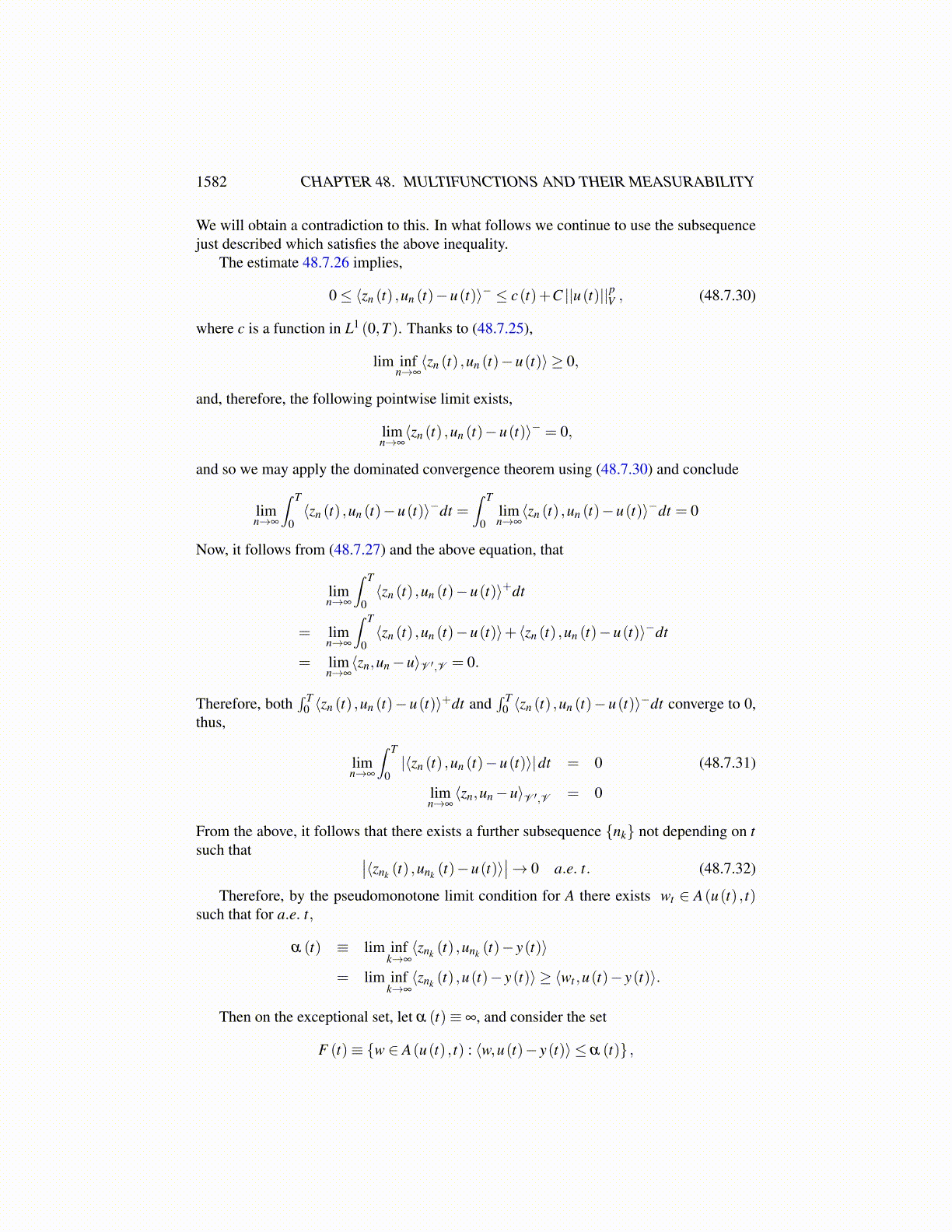
1582 CHAPTER 48. MULTIFUNCTIONS AND THEIR MEASURABILITY
Then, there exists a subsequence {nk}, which may depend on t, such that
limk→∞⟨znk (t) ,unk (t)−u(t)⟩= lim inf
n→∞⟨zn (t) ,un (t)−u(t)⟩< 0. (48.7.24)
Now, condition 3 implies that for all k large enough,
b3∣∣∣∣unk (t)
∣∣∣∣pV −b4 (t)−λ
∣∣unk (t)∣∣2H <
∣∣∣∣znk (t)∣∣∣∣
V ′ ||u(t)||V
≤(
b1∣∣∣∣unk (t)
∣∣∣∣p−1V +b2 (t)
)||u(t)||V ,
therefore,∣∣∣∣unk (t)
∣∣∣∣V and consequently
∣∣∣∣znk (t)∣∣∣∣
V ′ are bounded. This follows from 48.7.22in case λ > 0. Note that
∣∣∣∣znk (t)∣∣∣∣
V ′ is bounded independently of nk because of the assump-tion that A(·, t) is bounded and we just showed that
∣∣∣∣unk (t)∣∣∣∣
V is bounded.Taking a further subsequence if necessary, let unk (t)→ u(t) weakly in U ′ and unk (t)→
ξ weakly in V . Thus, by density considerations, ξ = u(t). Now, 48.7.24 and the limit con-ditions for pseudomonotone operators imply that the liminf condition holds.There existsz∞ ∈ A(u(t) , t) such that
lim infk→∞⟨znk (t) ,unk (t)−u(t)⟩ ≥ ⟨z∞,u(t)−u(t)⟩= 0
> limk→∞⟨znk (t) ,unk (t)−u(t)⟩,
which is a contradiction. This completes the proof of the claim.We continue with the proof of the theorem. It follows from this claim that for every
t /∈ Σ,lim inf
n→∞⟨zn (t) ,un (t)−u(t)⟩ ≥ 0. (48.7.25)
Also, it is assumed thatlim sup
n→∞
⟨zn,un−u⟩V ≤ 0.
Then from the estimates,∫ T
0
(b3 ||un (t)||pV −b4 (t)−λ |un (t)|2H
)dt ≤
∫ T
0∥u(t)∥V
(∥un∥p−1 b1 +b2
)dt
so it is routine to get ∥un∥V is bounded. This follows from the assumptions, in particular48.7.22.
Now, the coercivity condition 3 shows that if y ∈ Lp ([0,T ] ;V ), then
⟨zn (t) ,un (t)− y(t)⟩ ≥ b3 ||un (t)||pV −b4 (t)−λ |un (t)|2H−(
b1 ||un (t)||p−1 +b2 (t))||y(t)||V .
Using p−1 = pp′ , where 1
p +1p′ = 1, the right-hand side of this inequality equals
b3 ||un (t)||pV −b4 (t)−b1 ||un (t)||p/p′ ||y(t)||V −b2 (t) ||y(t)||V −λ |un (t)|2H ,